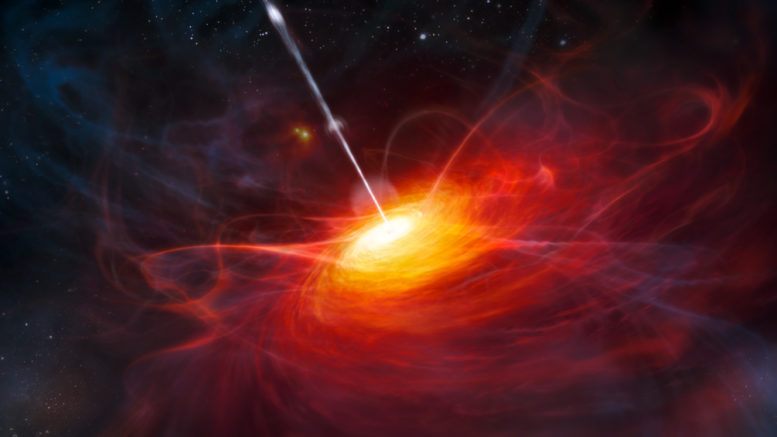The term quasar or quasars originated as a contraction of quasi-stellar radio source, because they were first identified during the 1950s as sources of radio-wave emission of unknown physical origin. It was first used in a paper by astrophysicist Hong-Yee Chiu in the May 1964 the paper that appeared in the publication Physics Today, to describe certain astronomically-puzzling objects:
So far, the clumsily long name ‘quasi-stellar radio sources’ is used to describe these objects. Because the nature of these objects is entirely unknown, it is hard to prepare a short, appropriate nomenclature for them so that their essential properties are obvious from their name. For convenience, the abbreviated form ‘quasar’ will be used throughout this paper.
Chiu, Hong-Yee (1964). “Gravitational collapse”. Physics Today. 17(5): 21. doi:10.1063/1.3051610
This has lead to the stellar object called a quasar to be known as an extremely luminous active galactic nucleus, in which a supermassive black hole is surrounded by a gaseous accretion disk. As gas in the disk falls towards the black hole, energy is released in the form of electromagnetic radiation, which can be observed across the electromagnetic spectrum.
The power that these objects radiate is enormous as it is theorized that the most powerful quasars have a luminosity equivalent to thousands of times greater than a galaxy such as the Milky Way. Nevertheless, scientists have found noticed through surveys that quasar activity was more common in the distant past, which seems to correlate the peak epoch of quasar activity was approximately 10 billion years ago.
History
The first quasars were discovered in the late 1950s, as radio sources in all-sky radio surveys. There have been many discoveries that have led to the current understanding of these monsters. It is worth noting that in 1979, the gravitational lens effect predicted by Einstein’s General Theory of Relativity was confirmed observationally for the first time with images of a double quasar.
Current Understanding and properties
Quasars inhabit the center of active galaxies, and are among the most luminous, powerful, and energetic objects known in the universe. The emitted radiation is spread across the electromagnetic spectrum, almost uniformly, from X-rays to the far-infrared with a peak in the ultraviolet-optical bands, with some are also being strong sources of radio emission and of gamma-rays. Light and other radiation cannot escape from within the event horizon of a black hole; therefore, the energy produced by a quasar is generated outside the black hole, by gravitational stresses and immense friction within the material nearest to the black hole, as it orbits and falls inward.
Types
There are different subtypes of quasars, all of which have distinct properties. These definitions can be found in the references below.
- Radio-loud quasars have powerful jets that are strong sources of radio-wavelength emission. These make up about 10% of the overall quasar population.
- Radio-quiet quasars are lacking powerful jets, with relatively weaker radio emission than the radio-loud population. The majority of quasars (about 90%) are radio-quiet.
- Broad absorption-line (BAL) quasars have spectra that exhibit broad absorption lines that are blueshifted relative to the quasar’s rest frame, resulting from gas flowing outward from the active nucleus in the direction toward the observer. Broad absorption lines are found in about 10% of quasars, and BAL quasars are usually radio-quiet. In the rest-frame ultraviolet spectra of BAL quasars, broad absorption lines can be detected from ionized carbon, magnesium, silicon, nitrogen, and other elements.
- Type 2 (or Type II) quasars have the accretion disk and broad emission lines are highly obscured by dense gas and dust. They are higher-luminosity counterparts of Type 2 Seyfert galaxies.
- Red quasars have optical colors that are redder than normal quasars, thought to be the result of moderate levels of dust extinction within the quasar host galaxy. Infrared surveys have demonstrated that red quasars make up a substantial fraction of the total quasar population.
- Optically Violent Variable (OVV) quasars are radio-loud quasars in which the jet is directed toward the observer. Relativistic beaming of the jet emission results in strong and rapid variability of the quasar brightness. OVV quasars are also considered to be a type of blazar.
- Weak emission line quasars have unusually faint emission lines in the ultraviolet/optical spectrum.
References and Further Reading
- Peterson, Bradley (1997). Active Galactic Nuclei. Cambridge University Press. ISBN 0 521 47911 8.
- Zakamska, Nadia; et al. (2003). “Candidate Type II Quasars from the Sloan Digital Sky Survey. I. Selection and Optical Properties of a Sample at 0.3<Z<0.83”. The Astronomical Journal. 126 (5): 2125. arXiv:astro-ph/0309551. Bibcode:2003AJ….126.2125Z. doi:10.1086/378610.
- Glikman, Eilat; et al. (2007). “The FIRST-2MASS Red Quasar Survey”. The Astrophysical Journal. 667 (2): 673. arXiv:0706.3222. Bibcode:2007ApJ…667..673G. doi:10.1086/521073.
- Diamond-Stanic, Aleksandar; et al. (2009). “High-redshift SDSS Quasars with Weak Emission Lines”. The Astrophysical Journal. 699(1): 782–799. arXiv:0904.2181. Bibcode:2009ApJ…699..782D. doi:10.1088/0004-637X/699/1/782.
https://www.space.com/17262-quasar-definition.html

These kind of post are always inspiring and I prefer to read quality content. Therefore, I am happy to find many first-rate points here in the post as the writing is simply great!! Thank you for the post, I will be back for other great content in the future.